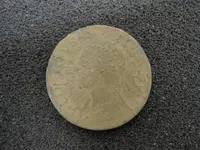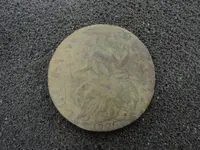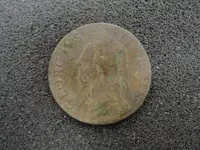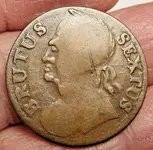paleomaxx
Hero Member
- Joined
- Aug 14, 2016
- Messages
- 841
- Reaction score
- 6,888
- Golden Thread
- 6
- Location
- Upstate, NY
- 🥇 Banner finds
- 6
- Detector(s) used
- Deus XP
- Primary Interest:
- All Treasure Hunting
No that's not a typo, the obverse is clearly a King George II left facing bust and the reverse is Britannia with 1775!


I haven't finished cleaning it, and at this point I'm still deciding how best to proceed. This came from a new spot I just discovered today in a field off to the side of a country intersection. It was insanely hot this morning and most of it is locked away under 3 foot weeds, but in under two hours I came up with three colonial coppers and a handful of relics so I was pumped! And very sweaty.
I saw the KGII bust out of the ground, but the reverse was covered in dirt; some tooth picking revealed the date. The obverse was stable at first, but it's drying out and flaking so I may have to tooth pick the front too and pray that it's still detailed.
What a hilariously bad counterfeit though! You have to wonder if even in it's day, it was obvious to anyone who got it that King George II was long dead by 1775 so it had to be a fake. I started looking online, but haven't found any other examples. I was hoping it was a Machin's Mills but it's not in the known die combinations. Could this be something new?
Could this be something new?
Update:
After much research it seems this is either unique or extremely rare. Online I found only two specific mentions of KGII half pennies dated 1775, one with no accompanying information and the other was a sales listing with photos, but both the obverse and reverse are completely different dies from this example. What I did find were many mentions of a flourishing counterfeit half-penny industry in New York State during the 1780's. In addition to Machin's Mills, there were counterfeit pieces being manufactured in New York City with dies cut by James Atlee.
I also found an article in Coinweek that suggests that Ephraim Brasher (of Brasher Doubloon fame) and John Bailey were involved in the manufacture as well. Because counterfeit operations would manufacture half pennies with multiple dates to lessen suspicion, my hypothesis is that at some point someone in the operation mismatched a pair of dies. The obverse from a fake KGII set and the reverse from a KGIII 1775 set. This may have only gone unnoticed for a handful of strikes before they corrected the mistake which is my there wouldn't be many around.
I checked and neither side of this coin matches the known Machin's Mills dies, but it could easily be from another counterfeiting operation. Hopefully I can dig up some more info, but if anyone recognizes the obverse or reverse from another die set definitely let me know!


I haven't finished cleaning it, and at this point I'm still deciding how best to proceed. This came from a new spot I just discovered today in a field off to the side of a country intersection. It was insanely hot this morning and most of it is locked away under 3 foot weeds, but in under two hours I came up with three colonial coppers and a handful of relics so I was pumped! And very sweaty.

I saw the KGII bust out of the ground, but the reverse was covered in dirt; some tooth picking revealed the date. The obverse was stable at first, but it's drying out and flaking so I may have to tooth pick the front too and pray that it's still detailed.
What a hilariously bad counterfeit though! You have to wonder if even in it's day, it was obvious to anyone who got it that King George II was long dead by 1775 so it had to be a fake. I started looking online, but haven't found any other examples. I was hoping it was a Machin's Mills but it's not in the known die combinations.
Update:
After much research it seems this is either unique or extremely rare. Online I found only two specific mentions of KGII half pennies dated 1775, one with no accompanying information and the other was a sales listing with photos, but both the obverse and reverse are completely different dies from this example. What I did find were many mentions of a flourishing counterfeit half-penny industry in New York State during the 1780's. In addition to Machin's Mills, there were counterfeit pieces being manufactured in New York City with dies cut by James Atlee.
I also found an article in Coinweek that suggests that Ephraim Brasher (of Brasher Doubloon fame) and John Bailey were involved in the manufacture as well. Because counterfeit operations would manufacture half pennies with multiple dates to lessen suspicion, my hypothesis is that at some point someone in the operation mismatched a pair of dies. The obverse from a fake KGII set and the reverse from a KGIII 1775 set. This may have only gone unnoticed for a handful of strikes before they corrected the mistake which is my there wouldn't be many around.
I checked and neither side of this coin matches the known Machin's Mills dies, but it could easily be from another counterfeiting operation. Hopefully I can dig up some more info, but if anyone recognizes the obverse or reverse from another die set definitely let me know!
Amazon Forum Fav 👍
Last edited:
Upvote
30







